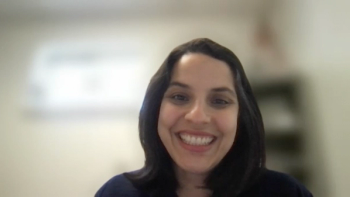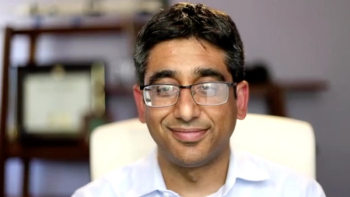
Recent FDA approvals and therapies under FDA review are adding new treatments to the armamentarium, said Paul Hahn, MD, vitreoretinal surgeon at NJRetina.

Recent FDA approvals and therapies under FDA review are adding new treatments to the armamentarium, said Paul Hahn, MD, vitreoretinal surgeon at NJRetina.

Patients with uveitis and their physicians may be very familiar with intravitreal injections, but triamcinolone acetonide injectable suspension (Xipere) has a novel delivery method, said Steven Yeh, MD, professor and the Stanley Truhlsen Jr. Chair in Ophthalmology at the Truhlsen Eye Institute, University of Nebraska Medical Center.

Different factors have contributed to the lack of racial diversity in ophthalmology residency programs, and these programs build the future of the workforce, said Parisa Emami-Naeni, MD, MPH, assistant professor of ophthalmology at University of California, Davis, and vitreoretinal surgeon and uveitis specialist at UC Davis Eye Center.

It is an exciting time in the field of retina for emerging technologies, said Paul Hahn, MD, vitreoretinal surgeon at NJRetina.

There has been a sea change in how retina specialists treat retinal diseases, with a progressive shift toward more utilization of anti–vascular endothelial growth factor (VEGF), said Paul Hahn, MD, vitreoretinal surgeon at NJRetina.

Different populations respond differently to drugs and treatments, but without adequate representation in clinical trials, it will be hard to judge the effectiveness of a new treatment, explained Vivienne Hau, MD, clinical assistant professor with the Kaiser Permanente Bernard J. Tyson School of Medicine.

Adequate training will help physicians and researchers better address the needs of the communities they’re targeting, explained Vivienne Hau, MD, clinical assistant professor with the Kaiser Permanente Bernard J. Tyson School of Medicine.

Insurance reimbursement for teleophthalmology services is not consistent among populations and only recently received a boost due to flexibilities allowed during the pandemic, said Parisa Emami-Naeini, MD, MPH, assistant professor of ophthalmology at University of California, Davis, and vitreoretinal surgeon and uveitis specialist at UC Davis Eye Center.

For vision-threatening diseases, such as diabetic macular edema (DME) understanding the economic value of treatments can help identify the direct and indirect benefits of different treatments, said Paul Hahn, MD, vitreoretinal surgeon at NJRetina.

Getting a more diverse patient population in clinical trials may be as simple as including paperwork in more languages, but good training among investigators and study coordinators can help identify unconscious biases that may also have an impact, explained Vivienne Hau, MD, clinical assistant professor with the Kaiser Permanente Bernard J. Tyson School of Medicine.

While prior authorizations are put in place to ensure appropriate use of expensive therapies, they create a substantial burden for clinicians and patients, said Sabin Dang, MD, ophthalmologist with The Retina Institute.

Two posters presented at the American Society of Retina Specialists 40th Annual Scientific Meeting evaluated the impact of the COVID-19 pandemic on rates of patients lost to follow-up and patient perspectives regarding telehealth for retinal disease.

Posters presented at the American Society of Retina Specialists (ASRS) 40th Annual Scientific Meeting evaluated the association between long-term visual acuity outcomes and use of anti–vascular endothelial growth factor (VEGF) therapy, as well as patient and caregiver experience with ant-VEGF.

While anti–vascular endothelial growth factor (VEGF) therapy is the first-line treatment for diabetic macular edema (DME), a majority of patients discontinue therapy after 6 months and there is no consensus on the ideal dosing paradigm.

Institutional racism within the medical field and the treatment of people from lower socioeconomic communities plays a large role in racial and ethnic inequities, explained Vivienne Hau, MD, clinical assistant professor with the Kaiser Permanente Bernard J. Tyson School of Medicine.

A machine learning model was able to predict visual outcomes and showed that the time from diagnosis to first treatment indicates visual improvement in patients with macular edema due to central retinal vein occlusion (CRVO).

Although technology is allowing for earlier detection of eye conditions, lack of reimbursement and insurance coverage remain major barriers to widespread use, explained speakers at the American Society of Retina Specialists 40th Annual Scientific Meeting.

At the beginning of the pandemic, remote retinal imaging declined sharply due to a recommendation to stop nonessential eye care services in the first months of 2020, said Parisa Emami-Naeni, MD, MPH, assistant professor of ophthalmology at University of California, Davis, and vitreoretinal surgeon and uveitis specialist at UC Davis Eye Center.

Every year, the American Society of Retina Specialists releases the results of its latest Preferences and Trends Survey at the annual meeting. This year, the survey highlighted some surprising differences between US and international retina specialists, including off-label medication use and what drives drug choices for patients, said Paul Hahn, MD, vitreoretinal surgeon at NJRetina.

The retina space is evolving due to new technology that is changing the way specialists deliver care, whether that means offering the ability to do new procedures in the office or providing more virtual or hybrid care.

During a session at the American Society of Retina Specialists 40th Annual Scientific Meeting, speakers highlighted research into the opportunity cost of vitreoretinal surgery and the impact the pandemic had on retinal procedures and reimbursement in early 2020.

Triamcinolone acetonide injectable suspension (Xipere) uses a novel delivery mechanism that seems to benefit all patients with macular edema due to noninfectious uveitis, regardless of where the inflammation occurs, said Steven Yeh, MD, professor and the Stanley Truhlsen Jr. Chair in Ophthalmology at the Truhlsen Eye Institute, University of Nebraska Medical Center.

The American Society of Retina Specialists (ASRS) will hold its 40th Annual Scientific Meeting in New York, New York, July 13-16, 2022.

Connecting with colleagues in person allows for meaningful conversations about the future of the retina care field and patients, said Steven Yeh, MD, professor and the Stanley Truhlsen Jr. Chair in Ophthalmology at the Truhlsen Eye Institute, University of Nebraska Medical Center.

259 Prospect Plains Rd, Bldg H
Cranbury, NJ 08512
© 2025 MJH Life Sciences®
All rights reserved.
